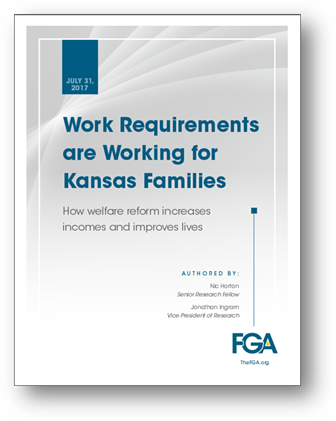TOPEKA – A new report from the Foundation for Government Accountability (FGA), released July 31, focuses on welfare reforms in Kansas and how they have positively impacted low-income residents who previously relied on cash assistance.
Among some of the findings, the incomes of Kansas families who left the Temporary Assistance for Needy Families (TANF) program, more than doubled in the first year, and eventually more than tripled. In total, families are now earning $48 million more per year than they had while receiving cash assistance.
“Our staff once again worked closely with FGA to supply data,” said Kansas Department for Children and Families (DCF) Secretary Phyllis Gilmore. “We are pleased to see the information shared turned into a meaningful report that demonstrates for Kansas and the rest of the nation that employment is the most effective path out of poverty.”
In February 2016, FGA released a similar study that focused on Kansans who received food assistance through the Supplemental Nutrition Assistance Program (SNAP). That study revealed before work requirements, 93 percent of able-bodied adults without dependent children (ABAWDs) on welfare were in poverty. Most were in severe poverty and not working at all. Within one year of leaving welfare, their incomes had more than doubled, an increase of 127 percent on average.
In 2015, Governor Brownback signed into law the Kansas HOPE Act, the most comprehensive welfare reform in the nation that not only added permanency to existing work requirements, but also added additional regulations to strengthen the integrity of the welfare benefits system in Kansas. Additional reforms to incentivize employment were enacted in 2016.
Other findings from this week’s FGA report on TANF (cash assistance):
- Kansans who regained their independence saw their incomes increase and surpass their previous earnings and welfare benefits combined.
- Kansans found employment in more than 600 industries, ranging from health care to finance to information technology.
- Fewer able-bodied adults dependent on welfare allowed Kansas to better focus resources on the truly needy.
“FGA’s past research has shown that the best way to free able-bodied, childless adults from the welfare trap is to get them back to work—the results of this study clearly indicate that the same is true for non-disabled parents. When able-bodied adults regain their independence, whether they have children or not, their incomes skyrocket and they’re able to lift themselves out of government dependence. That’s the power of work,” said Jonathan Ingram, FGA’s Vice President for Research.
Here’s a complete look at the report, Work Requirements are Working for Kansas Families: How welfare reform increases incomes and improves lives. For additional comment from FGA, please contact Whitney Munro at 239-244-8808.
Since January 2011, Kansas TANF clients have reported 43,046 new employments. In April 2017, their average hourly wage was $10.05. There are currently 11,139 Kansans receiving TANF, down from 38,963 in 2011.
Additional data on welfare benefits enrollment is available here. For more on welfare reforms in Kansas go to :
http://www.dcf.ks.gov/Newsroom/Pages/Keep-HOPE-Alive.aspx
http://www.dcf.ks.gov/Newsroom/Pages/HOPE.aspx

